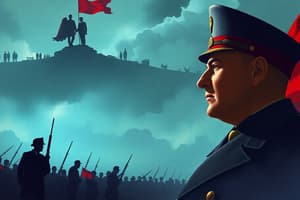Podcast
Questions and Answers
Who was Benito Mussolini?
Who was Benito Mussolini?
Fascist dictator of Italy.
What were the Black Shirts?
What were the Black Shirts?
A private army under Mussolini.
What was the March on Rome?
What was the March on Rome?
An event in 1922 that displaced King Victor Emmanuel.
What is a totalitarianism state?
What is a totalitarianism state?
Define fascism.
Define fascism.
How and why did fascism rise in Italy?
How and why did fascism rise in Italy?
What problems did Italy face after WW1?
What problems did Italy face after WW1?
What was one of Mussolini's economic or social goals?
What was one of Mussolini's economic or social goals?
List two similarities and two differences between fascism and communism.
List two similarities and two differences between fascism and communism.
What did Mussolini mean when he said, 'machines and women are the two main causes of unemployment'?
What did Mussolini mean when he said, 'machines and women are the two main causes of unemployment'?
Flashcards are hidden until you start studying
Study Notes
Benito Mussolini
- Fascist dictator of Italy, initially used intimidation to gain power but never achieved absolute control.
Black Shirts
- Mussolini’s private army that targeted socialist institutions, including newspapers and party headquarters, effectively reducing socialist influence in Northern Italy.
March on Rome
- Militant event in 1922, resulting in the displacement of King Victor Emmanuel and Mussolini's rise to leadership.
Totalitarian State
- A government model characterized by a one-party dictatorship that regulates all facets of citizens' lives.
Fascism
- A political ideology led by a dictator emphasizing extreme nationalism, racism, and intolerance for opposition.
Rise of Fascism in Italy
- Fascism gained traction by promising stability, a robust government, and an end to political strife that plagued post-WWI Italy.
Post-WWI Italy's Problems
- Italy faced significant challenges such as high unemployment, declining trade, rising taxes, and a fragmented government, which facilitated Mussolini's appeal.
Mussolini’s Economic and Social Goals
- Aimed for economic growth and resolution of workplace conflicts through state control over the economy, restricting strikes, and centralizing authority among business, labor, and government.
Fascism vs. Communism
- Both systems employed totalitarian regimes and claimed to act in the nation's interests. However, communism sought global revolution while fascism focused on nationalism; supporters differed as well, with communists appealing to the urban working class and fascists to business leaders and the lower middle class.
Mussolini's Views on Women and Unemployment
- Mussolini's remark about machines and women indicates a belief that both displaced men from jobs, reflecting policies that confined women to traditional roles, promoting their status as secondary to men.
Studying That Suits You
Use AI to generate personalized quizzes and flashcards to suit your learning preferences.



